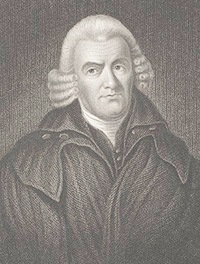
The son of poor parents, who both died in his early youth, John Brown (1722-87) – known as John Brown of Haddington – was born in Abernethy, Perthshire. He had little formal education, and supported himself at various times by working as a shepherd, a pedlar, a soldier (volunteering for the Fife regiment on the government side during the 1745 Jacobite rebellion), and a schoolmaster. Insatiable for knowledge, he taught himself Latin, Greek and Hebrew – and later Arabic, Syriac, Persian and Ethiopic, as well as the major modern European languages. This self-education secured him acceptance, in lieu of a university degree, for theological training under Ebenezer Erskine and James Fisher for the ministry of the Associate Synod church, and he became the minister of the Haddington (East Lothian) congregation of the Secession Church in 1751. Brown served this congregation for thirty-six years until his death, and was also, from 1767, the Synod’s professor, teaching all its ministerial candidates for the eight or nine weeks each year of their four- or five-year course. Brown crammed about 160 hours of instruction into these weeks, across all the disciplines.
John Brown’s renown is chiefly based on his The Self-Interpreting Bible, originally published in 1778, and to a lesser extent on A Dictionary of the Holy Bible (1769). ‘Brown’s Bible’ has often been reprinted, in America as well as in Britain. Its numerous aids for ‘the poorer and labouring parts of mankind’ included a system of marginal cross-references novel in its extensiveness. This ‘library in one volume’ became as common in Presbyterian homes as John Bunyan’s Pilgrim’s Progress and Thomas Boston’s Human Nature in its Fourfold State.
It could be said that Brown founded a ‘dynasty’, and many of his descendants were to become eminent ministers, scholars and public servants. In 1753 he had married Janet Thomson, with whom he had several children, two of whom, John Brown (of Whitburn) and Ebenezer, survived childhood – both of these following their father into the ministry. After Janet died in 1771, aged thirty-eight, Brown married Violet Croumbie in 1773. They had nine children, five of whom survived childhood, including William, who became secretary of the Scottish Missionary Society and author of a major work on the history of Christian missions, as well as being biographer of his father, and compiler of his literary ‘remains’ (The Life of John Brown with select writings, republished by the Trust in 2004).
John Brown died at the Associate Synod manse, Haddington, on 19 June 1787 after a long period of growing debility. He was buried four days later in Haddington churchyard.
In 1964 the Trust republished the biography John Brown of Haddington by Robert Mackenzie, but this is now out of print. There is an excellent summary of Brown’s life by David F. Wright in The Oxford Dictionary of National Biography.
